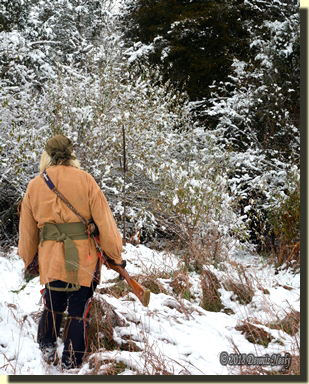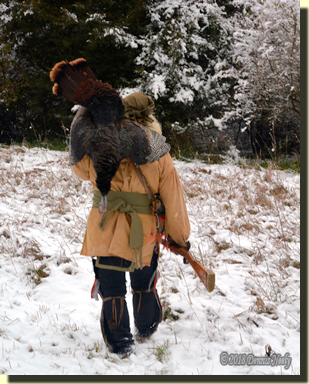Buffalo-hide moccasins still-hunted north. Intermittent gusts dislodged snow. At the wild apple that grew on the south edge of the cedar grove, wild turkey tracks zigged and zagged in and out of the border trees. Msko-waagosh stood, his eyes unraveling the birds’ morning search for sustenance. He needed to eat, too.
Around the bend he paused, tracking by sight only until the wandering trails crested the little knoll. To proceed farther created the risk of spooking the flock, should they be close ahead. He turned back, then stalked into the grove, skirting the west edge of an overgrown gully. The air smelled of wet cedar, cold and crisp.

With a pause interrupting each step, he crept down the hill, then lingered under another old apple tree. The great cottonwood towered sixty paces to the left. The mouth of the deep gully lined with box elder and wild cherry trees was to his right. He knelt, which gave him a fair view through the dead cedar branches, ahead and up the hillside. With nary a bronze beauty in sight, he eased on.
A hundred cautious paces down the doe trail, three wild cherry trees grew in a tight arch. Snow covered the bushes on either side of this nest. An inner voice told him, “Sit here! Do not go on!” The returned white captive did not move, struggling to interpret the premonition. A few minutes later, he decided to heed his wilderness instincts. His left moccasin cleared the snow from the grass. He slipped the bedroll from his shoulders, adjusted it against two of the trees, then sat.
Msko-waagosh checked the firelock’s prime, then eased the lock under his right arm, protecting it from falling snow. Deep in the trade gun’s bore, the death bees waited, perched upon two red oak leaves, rolled into a ball the size of a common death sphere, and under another, all tamped tight on a charge of black powder.
Perhaps twenty minutes later, a heavy wind whipped the cedar grove. Snow clumps flew, looking like the middle of a blizzard were it not for sunlight streaming through the waving tree tops. The gale ebbed. Then, as if an apparition, a dark shadow marched on the next doe trail to the west. Msko-waagosh did not move. “Lord, by your grace grant a clean kill or a clean miss,” he mouthed without showing his breath in the cold.
Do as they did…
Shooting a smoothbore flintlock seems popular of late. It wasn’t always this way. Many forum posts and a few magazine articles have addressed various aspects of the ballistics involved. Each has its own perspective and message, but the common thread is how to approach the performance of a modern shotgun. I have no argument with any of these musings. However, I march to a different drummer, as regular readers know.
The essence of traditional black powder hunting is figuring out what our forefathers did to survive in their wilderness world, and then take to the field to experience what they considered common place. These simple pursuits start by defining what resources they had at hand, duplicating those items and putting them to the test under first-hand conditions in the wilderness classroom.
This is not meant to be critical, but my hunter heroes do not mention chronographs, shot cups, Teflon-coated patches or the like—at least I’ve never found those items in the journal passages I’ve studied. And upon further examination, those “modern necessities” are never listed in any 18th-century trade goods inventory, either.
Now and again, one of these savvy old woodsmen will mention game getting away. They usually don’t say why, or tell of upping a powder charge, or patterning their load at the range. They learned from everyday living, good or bad. If they made a mistake, it could cost them their life, or in a lesser way, they went hungry.
That said, when I decide to use ancient methodology listed in a woodsman’s memoir, I test it out prior to depending upon it. Take the leaf and grass wadding that has become standard fare for all three of my alter egos over the last few years. I feel a responsibility to the game that I chase to make sure those loads kill in a humane and effective manner. I test them, just as the modern folks test their pet discoveries.
Further, I try to perfect the natural wadding loads that I use. Although I have not found specific documentation to support this practice, I believe at some point my hunter heroes tested loads, if by no other means than common observation. When I down a deer, I say a blessing, then before I begin the business of the forest, I study the wound, the effect of the death sphere and recover it, if possible.
John Tanner eluded to this power of observation in one of my favorite passages:
“…I had but seven balls left, but as there was no trader near, I could not at present get any more. With those seven I killed twenty moose and elk. Often times, in shooting an elk or a moose, the ball does not pass quite through, and may be used again…” (Tanner, 115).
His observation is that “often times…the ball does not pass quite through…” I would suggest that in Tanner’s experience sometimes it did. There is no question he understood the performance of his arm under a real-life hunting circumstances. Another time he talks of shooting at marks:
“We fixed a mark at a distance of one hundred yards, and I shot first, placing my ball nearly in the center. Not one of either party came near me…” (Ibid, 100).
With that practical knowledge, I often wonder if he backed down his powder charge a bit to ensure that those precious round balls did not pass through his family’s meat source. At the least, he understood how his gun performed out to one hundred yards, perhaps farther.
The point I wish to add to the current discussion is that there is an alternative to applying ballistic science to shooting a smoothbore. That alternative is to learn to use the arm as it was intended, loaded with the black powder measured by the trader’s handful and the round balls bought with prime beaver pelts, then produce an effective load using the natural materials found in the glade. My goal is, and has been, to live within those parameters, to give fair chase and provide wild game for the table in the manner of my forefathers.
Yes, I can kill wild turkeys with a Northwest gun stoked with cardboard and fiber wads soaked with special lubricants, but I can take that same turkey with a trade gun wadded with rolled red oak leaves plucked from a scrub tree. The gobbler roasts the same, but the challenge is greater, so is the satisfaction, and those two seasonings make the difference.

…three wild turkeys walked single file on the doe trail, twenty-three paces distant. With his right hand back, he brought the cock to attention. All three heads dropped down. The Northwest gun eased up. Then the three appeared a dozen paces to the south, beyond the trade gun’s effective distance.
In an instant, two more turkeys marched over the little rise, just as the first three had. The second bird paused as the first turkey’s head passed behind a cedar trunk. The turtle sight pulled right, then gripped that turkey’s eye. The English flint lunged. Sparks flew. Black powder flashed.
“Kla-whoosh-BOOM!”
The muzzle belched fire. A white, sulfurous stench billowed forth, engulfing the fowl. In an instant, Msko-waagosh scrambled to his feet. Long moccasin strides ate away the distance, then stood upon the bird’s purple legs, preventing its escape. In the silence of the wilderness, the returned white captive gave thanks for the blessing of that November day, in the Year of our Lord, 1796.
Give traditional black powder hunting a try, be safe and may God bless you.


